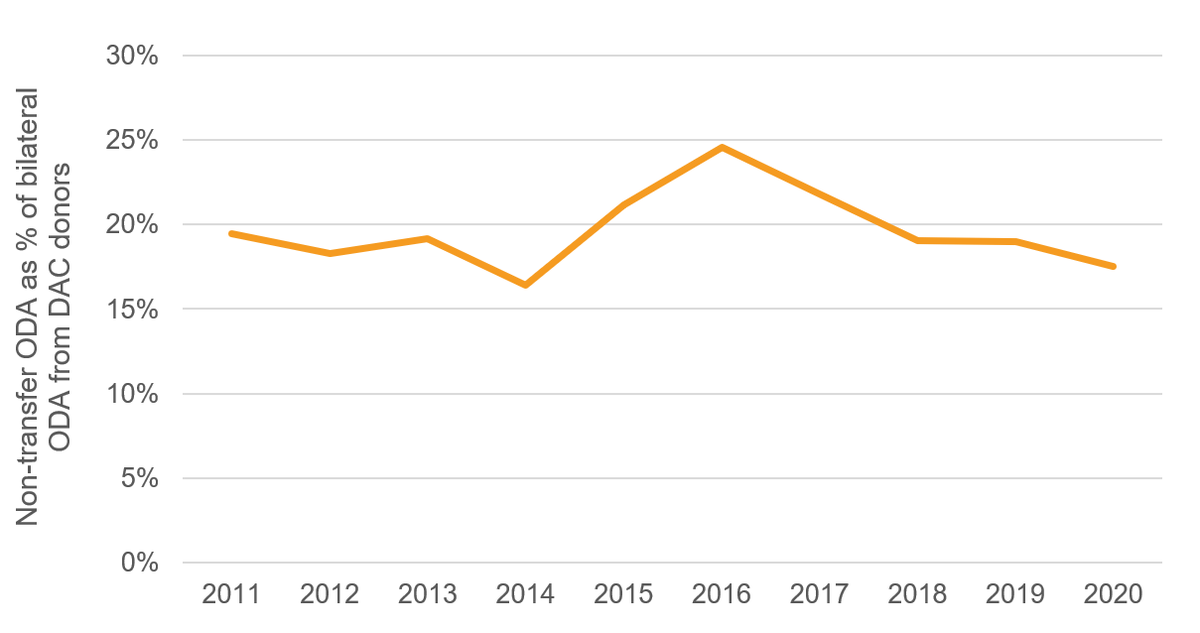ODA 2020–2021: Key trends before and during emerging crises
DI provides a baseline assessment of existing ODA trends that are being influenced by evolving global challenges including Covid-19 and conflict in Ukraine
DownloadsIntroduction
The world is undergoing a combination of crises that are unprecedented in recent history. The Covid-19 pandemic has caused not only enormous personal suffering, but also a massive global economic shock. With the pandemic not yet over, Russia’s invasion of Ukraine has, as well as its terrible human cost, resulted in a fresh refugee crisis that will inevitably require substantial donor investment. It has also contributed to a global rise in food and commodity prices that is set to cause hardship for people and places experiencing poverty and vulnerability. This briefing situates the trends in global ODA in the context of current international challenges.
These crises are occurring during a period of shifting trends in how the role of concessional international assistance is conceived and long-term changes in how official development assistance (ODA) is being spent. Simultaneously, these challenges are directly driving short- and potentially long-term changes in the allocations of aid as donors conduct strategic reviews of their portfolios.
The effects of these crises will take years to play out, informing both the importance of aid and potentially transforming the context in which its role will need to be considered. According to the latest estimates from the International Monetary Fund (IMF), [1] GDP will not recover to pre-pandemic levels in 30% of developing countries by the end of 2022. In the coming years, many countries will also face an increased burden of debt due to additional lending to developing countries by the IMF and other donors, aimed at cushioning the immediate economic impact of the pandemic. Rapid rises in the price of food and fuel related to the war in Ukraine are set to hit vulnerable populations in low-income countries hardest. The IMF predicts that, in 2022, the rate of inflation will average 8.7% in developing economies compared with 5.7% in advanced economies. When the war ends, the cost of rebuilding Ukraine will be enormous, and it is likely that developed country governments and the EU will provide significant funding for the rebuilding effort.
ODA donors will be faced with difficult choices regarding how to respond to these issues. Increased costs associated with refugees and funding for reconstruction in Ukraine may squeeze the funding available for wider developmental activity. This could result in some of the poorest countries in the world receiving a smaller share of ODA even as they face mounting problems of debt, restricted growth and inflation.
This briefing is intended to act as a baseline assessment of existing ODA trends which will undoubtedly be influenced by these global challenges. This work will be built on through a series of activities to track the allocation of ODA as the effects of these crises unfold through 2022 and beyond. It covers the activities of all Development Assistance Committee (DAC) members and official-sector multilateral organisations, and it draws insights from the latest ODA data releases to examine trends in overall levels of ODA and ODA to the poorest countries, paying attention to the increasing use of loans in the delivery of ODA. It also looks at the sectors supported by ODA, with a special focus on Covid-related ODA in the first two years of the pandemic and an analysis of those ODA modalities which do not result in a transfer of resources to developing countries. International Aid Transparency Initiative (IATI) data for 2021 is available for a number of donors and this is used in relevant sections where Organisation for Economic Cooperation and Development (OECD) data is not yet available in order to give an early indication of trends in that year.
Box 1
About the data in this paper
This briefing brings together data from the OECD Development Assistance Committee (DAC), which provides complete and verified ODA data, and therefore an important and detailed picture of what has been happening to aid. Preliminary top-level data for donor ODA has been made available for 2021 following the OECD DAC April 2022 data release. Fully disaggregated OECD DAC data is, however, published at least a year in arrears, meaning that the latest detailed aid data is available only up to the end of 2020. This briefing uses both forms of data where it is available.
Data from the International Aid Transparency Initiative (IATI) is also used in this briefing. IATI is a global initiative working to improve the transparency of development and humanitarian resources that address poverty and crises. It is a voluntary standard to which many major donors publish, although timeliness, frequency and quality of reporting vary by reporting organisation. Not all donor agencies report reliable data to IATI. Therefore, where IATI data is discussed in this briefing, it refers only to data from donors with a good standard of IATI reporting. The full list of agencies and actors covered in the IATI data used to produce this briefing is available in Annex 1 .
Key findings
Headline ODA rose by US$7 billion to a new peak of US$179 billion in 2021 ( Figure 1 ).
The majority of this increase (US$6.3 billion) was due to the inclusion of donated vaccine doses which were reported as ODA for the first time in 2021. This suggests that vaccine doses were additional to, rather than substituting for, other forms of ODA.
There was a shift towards multilateral ODA in 2021.
Multilateral ODA rose by US$4.9 billion while bilateral ODA (excluding donated vaccine doses) fell by US$4.2 billion.
The UK’s abandonment of the 0.7% target reduced the number of countries achieving this level of ODA to five from six ( Figure 2 ).
The UK recorded by far the largest fall in ODA of any DAC member, with ODA down by 21% (or US$4.26 billion) between 2020 and 2021. Luxembourg, Norway, Sweden, Germany and Denmark all maintained a level of ODA greater than 0.7% of GNI.
In 2021, over 10%, or US$18.7 billion, of ODA related to the Covid-19 pandemic ( Figure 4 ).
Of this total, US$6.3 billion took the form of donated vaccine doses and US$12.4 billion was dedicated to other Covid-related activities, including the supply of medical equipment and the training of personnel. There is, as yet, insufficient data for 2021 to judge the effect of this non-vaccine Covid-related spending on other areas of ODA spending.
The US donated the majority of vaccine doses reported as ODA – US$4 billion. Japan, Germany and Canada contributed the largest amounts of non-vaccine Covid-related ODA ( Figure 4 ).
The great majority (US$3.5 billion) of the US$4 billion in vaccine doses reported by the US were doses bought for developing countries. By contrast, virtually all of the US$2.3 billion of vaccine doses reported as ODA by other donors were from excess domestic supply.
Loans, which had already increased significantly since the beginning of the decade to 2019, spiked in 2020 ( Figure 6 ).
One-third of bilateral ODA in 2020 was in the form of loans, compared to just over a quarter in 2019. The largest single factor in this increase was a major increase in budget support lending from the IMF. This could lead to increased problems of debt sustainability in many countries. Debt issues may be exacerbated by the fact that IMF loans typically have shorter maturity periods (10 years or less) than loans from other donors.
Aid to least developed countries (LDCs) increased in 2020 but, again, most of the increase was in the form of additional lending ( Figure 7 ).
Lending to LDCs had risen steadily during the period 2011–2019 while grant funding remained flat. The additional lending in 2020 accelerated this trend. In 2020, loans accounted for one-third of bilateral ODA to LDCs, compared to just 12% in 2011.
Changes to the sectoral make-up of ODA took place during the first year of the pandemic ( Figure 9 ).
Unsurprisingly, spending on infrastructure fell by 8%, but there was also a 12% reduction in spending on water and sanitation projects. This was offset by a large (350%) increase in general budget support to developing countries and a significant increase (30%) in spending on health.
Global trends in ODA
Preliminary data released by the OECD DAC shows that total ODA increased by US$7 billion, or 4.1%, in real terms between 2020 and 2021, to reach US$179 billion. One major factor in this rise was the decision to allow donors to include the value of donated Covid-19 vaccination doses in their ODA figures. These donated vaccines accounted for US$6.3 billion, with the majority (US$4 billion) coming from the US. As noted elsewhere, the great majority of vaccine doses donated by the US were specifically purchased for developing countries, while vaccine doses from other donors came from excess stock within the donor countries.
Another factor contributing to the overall rise in ODA was the increase of US$4.9 billion in donor contributions to multilateral organisations between 2020 and 2021. In contrast, bilateral ODA, excluding vaccine donations, actually fell by US$4.2 billion year-on-year between 2020 and 2021.
Figure 1: ODA hit a new peak in 2021, mainly driven by the inclusion of donated vaccine doses
Headline ODA for all DAC donors 2011–2021
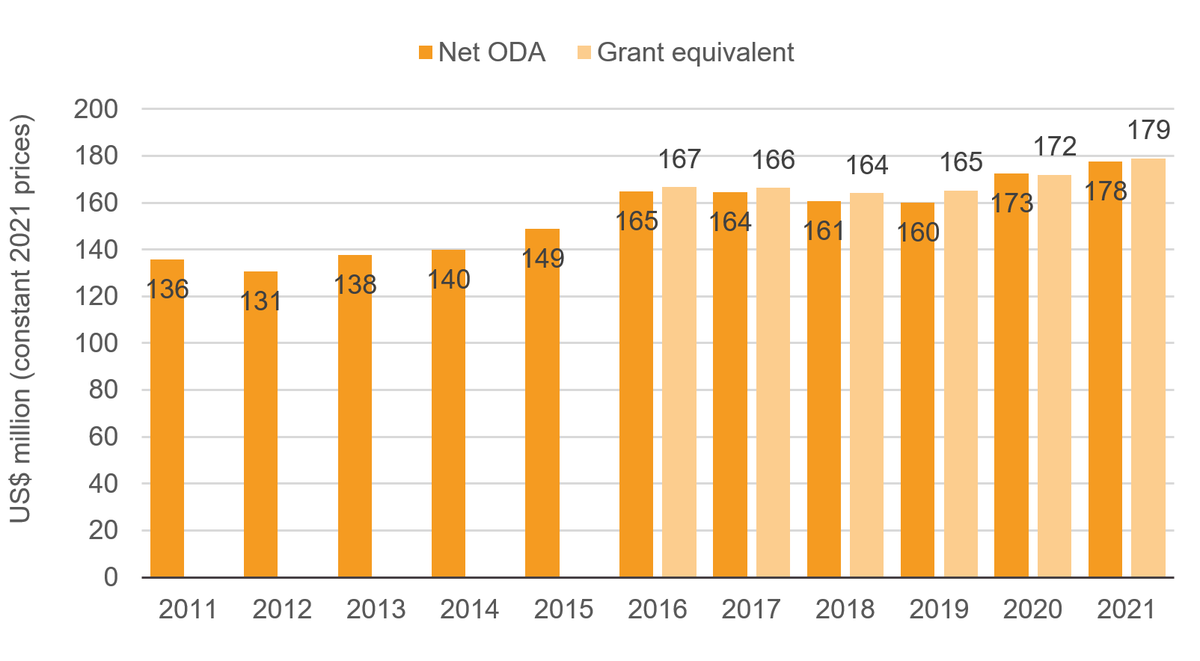
Bar chart showing that ODA hit a new peak in 2021, mainly driven by the inclusion of donated vaccine doses
Source: OECD DAC.
Notes: ODA = official development assistance. The chart shows net ODA and grant-equivalent ODA for the years in which they respectively represented headline ODA. The difference between the old (net ODA) and new (grant-equivalent) measure is attributed to the way that ODA loans are accounted for; under the old measure the full face value of the loan is reported with loan repayments subtracted, while under the new measure only the grant equivalent of the loan is reported (and loan repayments are not subtracted).
Most DAC donors increase ODA contributions
The majority of DAC donors (23 out of 29) increased their overall ODA levels between 2020 and 2021. The largest rise was reported by the US with a US$5.3 billion increase from 2020 – as noted in Key Findings , US$4 billion of this was in the form of vaccine donations which were not previously included in ODA.
Other donors who reported significant increases in ODA were: Japan (US$1.9 billion), Germany (US$1.6 billion) and Italy (US$1.5 billion).
These increases were partially offset by a very large reduction in ODA from the UK which reported a fall in ODA of US$4.3 billion, or 21%. This was the result of the UK’s decision to abandon the 0.7% ODA/GNI target.
ODA from Sweden also fell by US$1.1 billion, or 16%. This was entirely due to decreased funding to multilateral organisations following an unusually large amount of multilateral ODA reported by Sweden in 2020.
To see a full list of how DAC donors’ ODA changed between 2020 and 2021, see Table 1 in Annex 2 .
Five donors continued to meet the 0.7% ODA target
In 2021, five donors achieved an ODA/GNI level of 0.7% or higher: Luxembourg, Germany, Norway, Sweden and Denmark. Germany rejoined this group in 2019 and has maintained this level of ODA since.
The UK’s abandonment of the 0.7% target saw it fall from being the sixth most generous donor on this measure to the ninth. Luxembourg, Sweden, Norway and Denmark also reported significant falls in their ODA/GNI contributions, but all remained well above the 0.7% target.
Figure 2: The number of donors meeting the 0.7% ODA/GNI target fell from six to five
ODA as a % of GNI, by donor
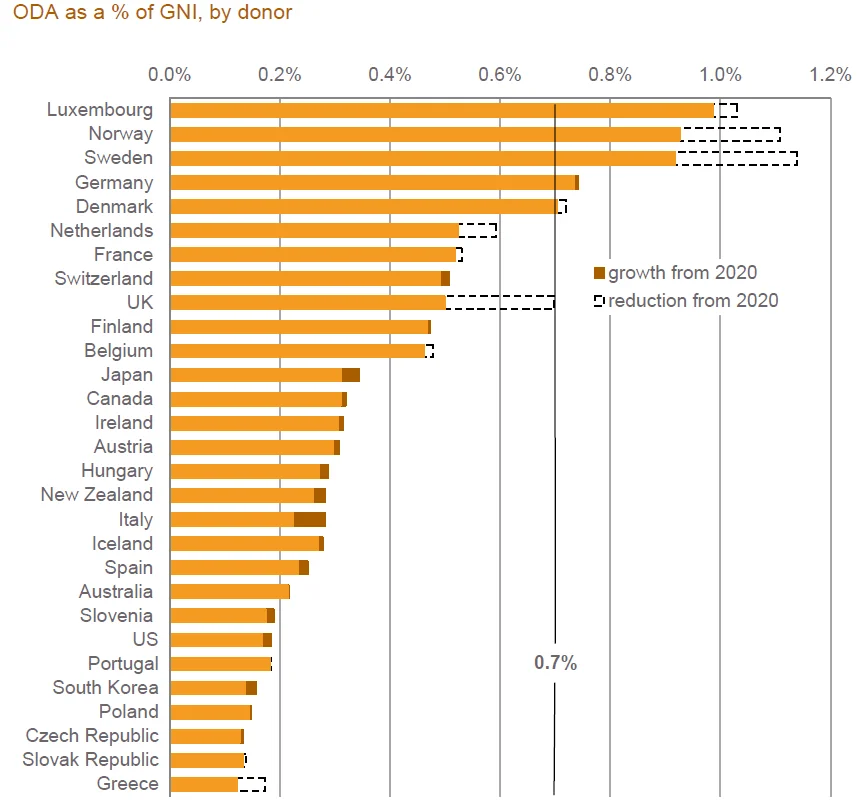
Chart showing that the number of donors meeting the 0.7% ODA/GNI target fell from six to five
Source: OECD DAC.
Notes: ODA = official development assistance. The ODA/GNI % shown in the chart is based on grant-equivalent ODA.
As in 2019, the three largest recipients of ODA were Bangladesh, Ethiopia and Afghanistan.
However, Bangladesh replaced Ethiopia as the single largest recipient. ODA levels more than doubled in Ukraine, Ghana and Morocco, resulting in these countries joining the list of top ODA recipients. The increase in ODA to Ukraine was a result of significant budget support loans from the EU. Ghana received a large increase in budget support lending from the IMF, while Morocco received increased ODA from both the EU and Germany, mainly for budget support and Covid-19-related activities
ODA to India fell by a third, resulting in India dropping out of the top 20 recipients (from 8th in 2019 to 23rd in 2020). This was due to a reduction in ODA loan disbursements from Japan.
To see a list of the top 20 recipients of ODA in 2020, see Table 2 in Annex 3 .
Covid-19 prompts a rise in ODA to specific developing countries
Between 2013 and 2019 there was a general trend for a decreasing proportion of ODA to be allocated to specific developing countries. During this period an increasing proportion of ODA reported by donors did not specify a recipient. [2] This form of ODA does not target specific people or places, and it includes a range of activities such as the costs of hosting refugees, administrative costs, recapitalisation of national development finance institutions, global programmes and global public goods (including research). While aid supporting global public goods may benefit people in poverty, it neither explicitly targets nor disproportionately benefits people in extreme poverty. In 2013 just over three quarters of ODA was allocated to specific countries, but between 2015 and 2019, this proportion fell to just over two thirds. As a result, some individual nations received reduced levels of ODA.
In 2020, in response to the economic impact of the Covid-19 pandemic, there was a large increase in multilateral loans to developing country governments, especially from the IMF but also from regional development banks, the World Bank and the EU. These loans were issued to specific countries, which somewhat reversed this earlier trend. In 2020, 72% of ODA disbursements specified a recipient country.
Data from IATI for 2021 suggest that 2020 may have been an anomaly as, among many large donors that report well to IATI, the proportion of ODA specifying a recipient country fell from 2020 to 2021. Considering only well-reported donor organisations, [3] country-specific projects fell from 78% in 2018 to 75% in 2021. Notably, both USAID and the World Bank, the two largest donors with a track record of effective reporting to IATI, reduced their country-specific aid by 8% and 2% respectively from 2020 to 2021.
Figure 3: An increase in budget support in 2020 reversed the recent trend of a rising proportion of ODA not being allocated to specific countries
Country-specific and non-country-specific ODA (in US$) from 2010–2020
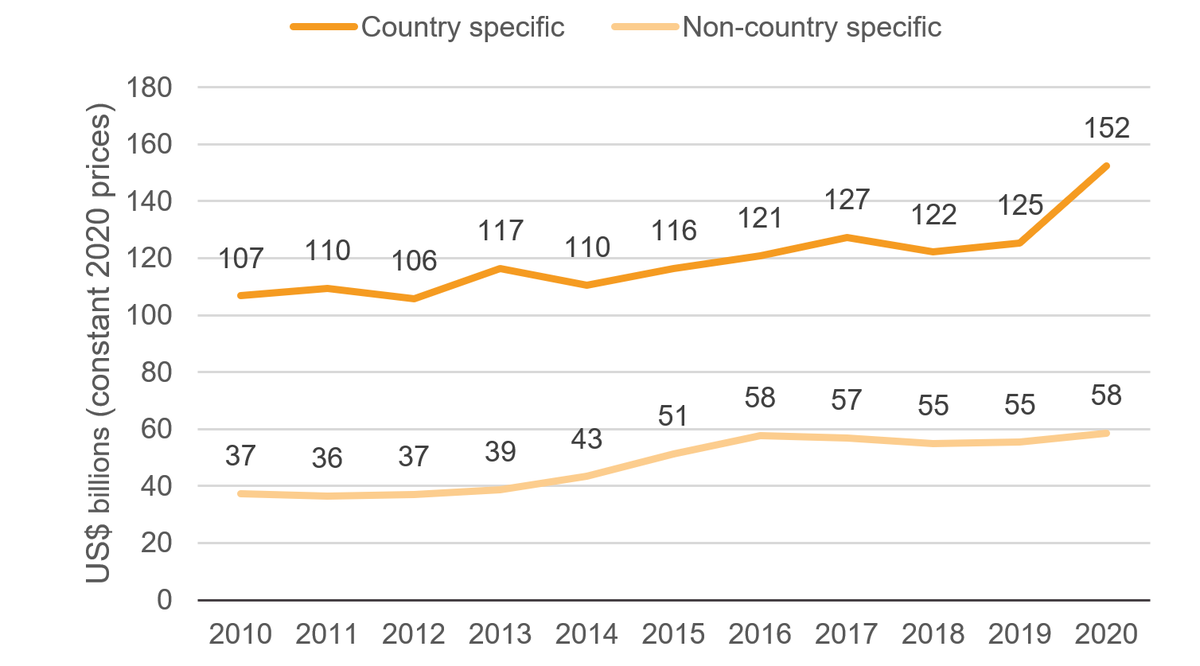
Chart showing that an increase in budget support in 2020 reversed the recent trend of a rising proportion of ODA not being allocated to specific countries
Source: OECD DAC.
Notes: Non-country specific ODA includes activities with an unspecified recipient and regional ODA that is not allocated to a specific country.
The impact of Covid-19 on ODA
Covid-related activities accounted for 10.5% of ODA from bilateral donors in 2021
For 2020 ODA, the OECD DAC instituted a new purpose code in the data for activities specifically aimed at Covid-19 control. The updated reporting guidance describes this purpose code as being for “all activities related to Covid-19 control e.g. information, education and communication; testing; prevention; immunisation, treatment, care”. During that year DAC donors and multilateral bodies reported US$4 billion in ODA to this code. Three quarters of this amount came from five donors: Germany (US$922 million), Japan (US$779 million), South Korea (US$451 million), the US (US$436 million) and the UK (US$418 million).
This excludes activities carried out in response to the Covid-19 pandemic which were not specifically aimed at Covid-19 control – for example, budget support aimed at counteracting the economic effects of the pandemic.
In 2021, the DAC allowed the value of vaccine doses donated to developing countries to be included in ODA. [4] In the preliminary ODA data for 2021, the DAC included figures for bilateral donors showing the value of vaccine donations included in ODA, together with other Covid-related ODA. This second category included activities coded as Covid-19 control and activities under other purpose codes where Covid-19 was included in the ‘keyword’ field of the Creditor Reporting System (CRS) activity record.
This gave a total of US$6.3 billion in donated vaccines counted as ODA and a further US$12.4 billion in other Covid-related activities. This gives an overall total of US$18.7 billion of Covid-related ODA from bilateral donors in 2021 – 10.5% of the total ODA from these donors.
The US reported by far the largest amount of vaccine donations as ODA in 2021: US$4 billion. Of this, US$3.5 billion was in the form of vaccine doses specifically purchased for developing countries, with the remainder being from excess domestic supply. By contrast, virtually all of the US$2.3 billion of vaccine doses reported as ODA by other donors were from excess domestic supply. Japan and Germany reported the largest amount of non-vaccine Covid-related ODA: US$3.6 billion and US$2.3 billion respectively.
Regional Covid-related ODA
There is no regional breakdown of the Covid-related ODA spending in 2021. However, using the new ‘Covid-19 control’ purpose code, it is possible to geographically break down Covid-related spending in 2020.
Almost half of this spending in 2020 was not allocated to specific countries; this funding was typically used either for vaccine research or Covid-related trust funds. Where recipient countries were specified, Sub-Saharan Africa was the largest recipient region followed by Far East Asia, and South and Central Asia.
Figure 5: Almost half of Covid-related ODA in 2020 was not targeted at specific countries
Regional split of funding to Covid-19 control from DAC donors in 2020 (US$ million)
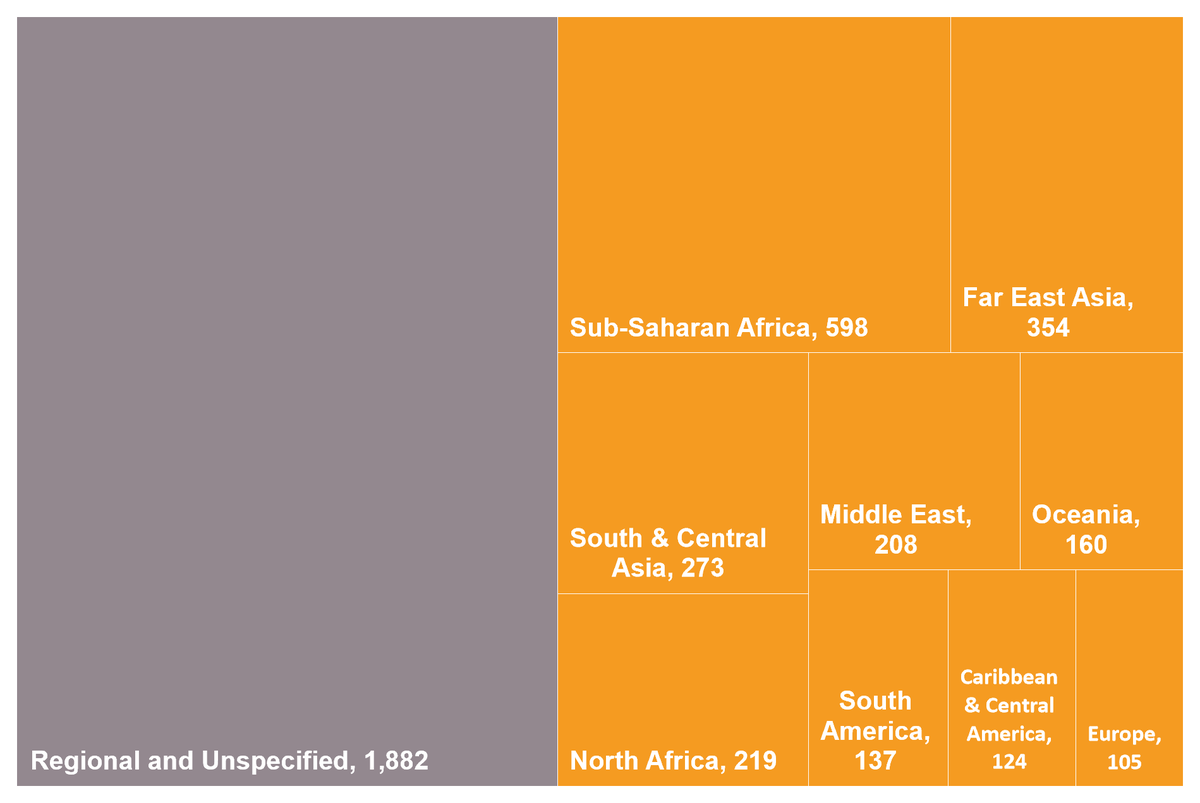
Treemap showing that almost half of Covid-related ODA in 2020 was not targeted at specific countries
Source: OECD DAC.
Note: Data taken from final ODA data for 2020 – no regional breakdown of activities has yet been published for 2021.
Loan use in ODA continues to escalate
Lending by multilateral organisations and some DAC members rises significantly
Prior to the Covid-19 pandemic, ODA loans were already growing at a much faster rate than grants. Between 2011 and 2019, ODA loan disbursements rose by 46% compared to a rise of 19% in grant funding. The onset of the pandemic saw a large acceleration in this trend with ODA loan disbursements rising by a further 50% in 2020 alone, giving an overall rise in ODA loans of 119% between 2011 and 2020.
The overwhelming majority of loans from bilateral donors originate from three DAC members: Japan, Germany and France. All three substantially increased their loan disbursements between 2019 and 2020: France recorded a 59% rise (from US$4.6 billion in 2019 to US$7.4 billion in 2020); loans from Germany increased by 36% (from US$4.7 billion to US$6.4 billion); and loans from Japan increased by 18% (from US$9.7 billion to US$11.4 billion).
Some DAC members who, historically, gave only a small proportion of their ODA in the form of loans also increased their lending. Canada more than doubled its ODA loans between 2019 and 2020 (from US$170 million to US$352 million); Italy trebled its lending (from US$120 million to US$367 million); and Switzerland increased loan disbursements eightfold (from US$32 million to US$256 million). In total, loans from DAC members increased by US$7.3 billion or 35%, from US$20.5 billion to US$27.8 billion.
Loans from multilateral organisations grew even more rapidly in 2020, by US$16.2 billion or 62%, from US$26.1 billion to US$42.3 billion in aggregate. Almost half of this increase in bilateral lending was due to a large increase in budget support loans from the IMF to help developing countries deal with the economic impacts of the Covid-19 pandemic. ODA loans from the IMF increased from US$1.5 billion in 2019 to US$9.5 billion in 2020 – more than a sixfold increase.
ODA loans from the EU doubled in 2020 from US$3.5 billion in 2019 to US$7 billion. Lending from regional development banks (RDBs) also rose sharply – by US$2.7 billion or 58% (from US$4.7 billion in 2019 to US$7.4 billion in 2020). The World Bank, the largest multilateral lender, increased its ODA loans by a more modest 7% or US$1 billion (from US$14.8 billion to US$15.8 billion)
Early indications from IATI data suggest that the increase in loans in 2020 may prove to be a temporary spike. Two RDBs, the African Development Bank (AfDB) and the Asian Development Bank (ADB) both reduced lending by 43% and 42% respectively in 2021 compared to 2020. Lending from the World Bank reported to IATI showed a further modest rise of 4% between 2020 and 2021.
The rise in ODA loans particularly affects least developed and low-income countries
One notable point about the increase in ODA loans over the last decade is the fact that lending to the countries experiencing the greatest poverty grew much more rapidly than lending to other developing countries. Between 2011 and 2020, ODA loans to least developed countries (LDCs) and low-income countries (LICs) grew by 300%, while loan disbursements to middle-income countries (MICs) grew by 76% over the same period. In 2011, just 12% of ODA disbursed to LDCs and LICs was in the form of loans, by 2020 one third of ODA to these countries was in the form of loans – levels of ODA grants remained flat over this period.
Figure 6: ODA loans rose sharply in 2020
ODA loans, split by recipient income group

Bar chart showing that ODA loans rose sharply in 2020
Source: OECD DAC.
Note: Data from DAC members and multilateral bodies. LDC = least developed countries; LIC = low-income countries; LMIC = lower-middle-income countries; UMIC = upper-middle-income Countries. Only two LICs (Zimbabwe and the Democratic People’s Republic of Korea) are not part of the LDC grouping – data for these countries has been included with the data for LDCs to create a combined LDC/LIC group in Figure 6.
ODA to least developed countries (LDCs)
Among developing countries, LDCs face the most difficult developmental challenges. Extreme poverty has become increasingly concentrated in LDCs: in 2010, 31% of people living in extreme poverty were in LDCs, but this proportion increased to 50% by 2020, and is projected to increase to 57% by 2025. [5]
LDCs also suffer from low domestic resources which leaves them with significant funding shortfalls to support critical Sustainable Development Goals (SDGs). This is compounded by the fact that, compared to other developing countries, LDCs capture less of key international financial flows such as foreign direct investment (FDI), export credits, remittances and tourism receipts.
Increasing ODA to LDCs could reduce poverty-related issues in these countries
These factors present a strong case for focusing ODA on LDCs in order to tackle persistent problems of poverty and to help address problems arising from a lack of funding from other sources. However, the data shows that ODA disbursements to LDCs have largely stagnated and that any increase in ODA to LDCs has been the result of increased lending by donors to these countries. Despite the increasing concentration of extreme poverty in LDCs, the proportion of ODA disbursed to LDCs was exactly the same in 2020 as it was in 2011 – 32%. In the intervening years between 2011 and 2020 the proportion of ODA disbursed to LCDs was consistently lower than this – falling as low as 27% in 2016.
Figure 7: ODA to LDCs rose slowly prior to the pandemic, with loans forming an increasingly large proportion of disbursements
ODA to LDCs 2011–2020, split by grants and loans
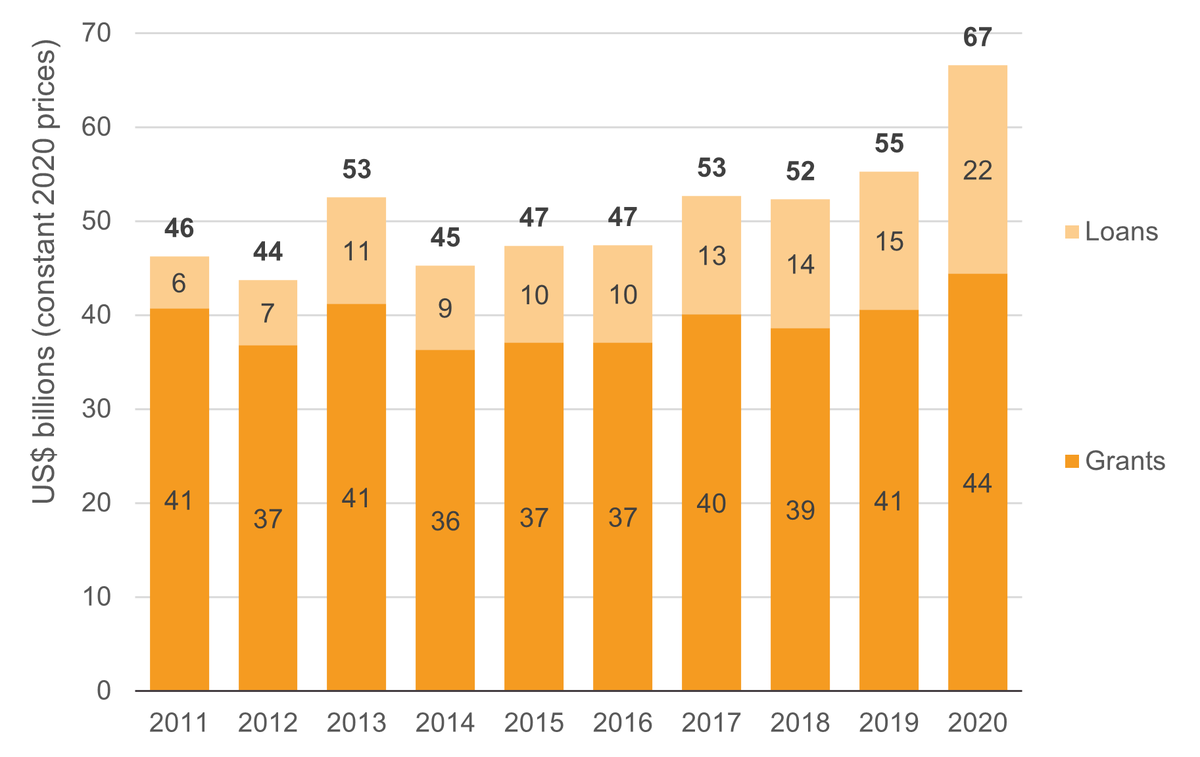
Bar chart showing that ODA to LDCs rose slowly prior to the pandemic, with loans forming an increasingly large proportion of disbursements
Source: OECD DAC.
Note: Data from DAC members and multilateral bodies. LDCs = least developed countries
Meeting the 0.15–0.20% GNI target
The established target for ODA to LDCs, emerging from the 2011 Istanbul Programme of Action for LDCs , is that DAC donors should provide 0.15–0.20% of their gross national income (GNI) as ODA to LDCs. In 2021, 10 DAC donors met or exceeded this target while 19 donors fell short. On average, DAC donors gave less than 0.11% of GNI as ODA to LDCs.
If the 19 donors which gave less than 0.15% had achieved this level in 2021, ODA to LDCs would have been US$85 billion, US$19 billion more than was actually given. If all the DAC donors that gave less than 0.2% of GNI as ODA to LDCs had achieved that level in 2021, ODA to LDCs would have reached US$109 billion, US$ 43 billion more than was actually given.
Figure 8: Most donors did not meet the target of giving 0.15%–0.2% of GNI as ODA to LDCs in 2021
DAC donors’ ODA to LDCs in 2021 as a percentage of GNI
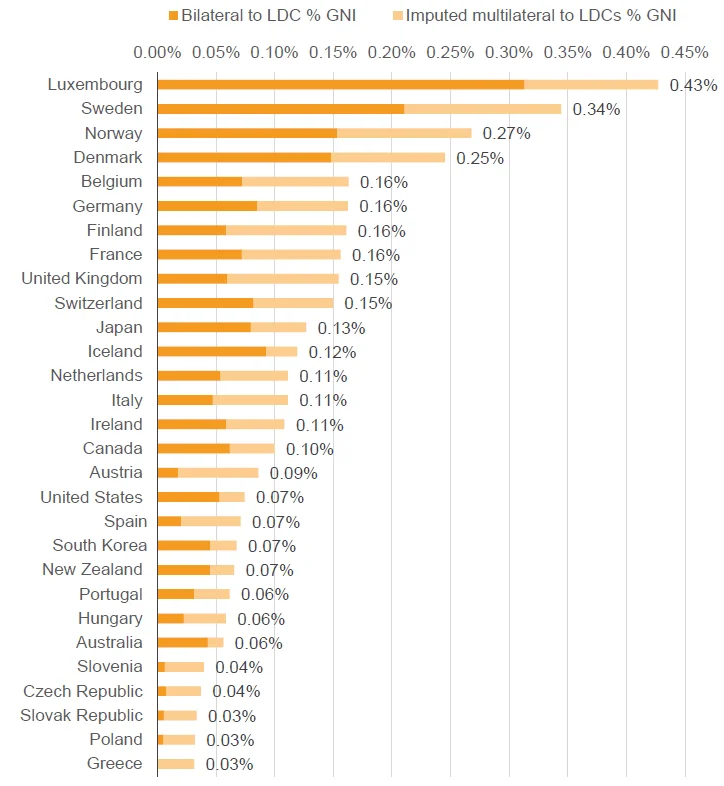
Chart showing that most donors did not meet the target of giving 0.15%–0.2% of GNI as ODA to LDCs in 2021
Source: OECD DAC.
Notes: Imputed multilateral ODA to LDCs refers to the estimate of the UK’s unearmarked multilateral ODA that is disbursed to LDCs from multilaterals. The share of core multilateral ODA is calculated by applying the volume of the UK’s core multilateral ODA to the share of total expenditure that each multilateral provides to LDCs.
Sectoral shifts in ODA
For most sectors the proportion of allocated ODA remained largely unchanged in 2020 compared to 2019. However, the large amount of budget support loans from multilateral lenders resulted in budget support accounting for a much greater proportion of ODA than in previous years (8% of ODA in 2020 was budget support, compared to just 2% in 2019).
Spending on health rose by US$6.6 billion, or 30%, between 2019 and 2020. However, this did not translate into a large increase in the proportion of ODA allocated to health. The very large increase in the proportion of ODA going to budget support meant that the proportion of ODA allocated to health increased only slightly from 12% in 2019 to 13% in 2020.
ODA to governance and security also showed a marked increase in the first year of the pandemic, rising by US$4.2 billion or 20%. This increased the share of total ODA to this sector to 12% from 11% in 2019.
Spending on infrastructure projects slowed in the first year of the Covid-19 pandemic as Covid-related restrictions hampered work on physical projects. Infrastructure accounted for 14% of ODA spending in 2019, but this share fell to 11% in 2020. In real terms ODA spending on infrastructure fell by almost US$2 billion between 2019 and 2020. This fall was almost entirely concentrated in the area of transport and storage. The single largest factor contributing to this decrease was a US$1 billion reduction in Japanese funding for transport projects in India.
Funding for water and sanitation projects also fell in real terms. The water and sanitation sector received US$822 million (12%) less ODA in 2020 compared to 2019. This fall was principally due to substantial reductions in spending by four donors: the World Bank (down by US$388 million), Japan (down by US$292 million), the DP R K (down by US$149 million), and the UK (down by US$99 million).
The amount of ODA reported as in-donor refugee costs also fell by US$1.3 billion in 2020, or 13%, compared to 2019, as the impactof the Syrian refugee crisis on ODA continued to lessen.
Changing trends in 2021
Data from IATI for 2021 suggests that major donors have restored spending on infrastructure projects in 2021. Most notably, the World Bank has increased disbursements to infrastructure by US$967 million in 2021, more than reversing the cut it made in 2019 to the sector. Providing the second- and third-largest volume increases to the sector, AfDB and ADB increased disbursements to infrastructure by US$439 million and US$288 million in 2021 respectively; the vast majority of these disbursements were provided as loans. Water and sanitation disbursements appear to have seen a partial restoration with the World Bank increasing spending by US$204 million in 2021 compared to 2020, restoring half of the US$466 million cut to the sector in 2020. Denmark increased disbursements to water and sanitation by the second-largest volume of US$109 million in 2021.
Figure 9: ODA to budget support, health and governance increased in 2020, while spending on infrastructure and water and sanitation saw the largest fall from 2019
Sector split of ODA in 2019 and 2020
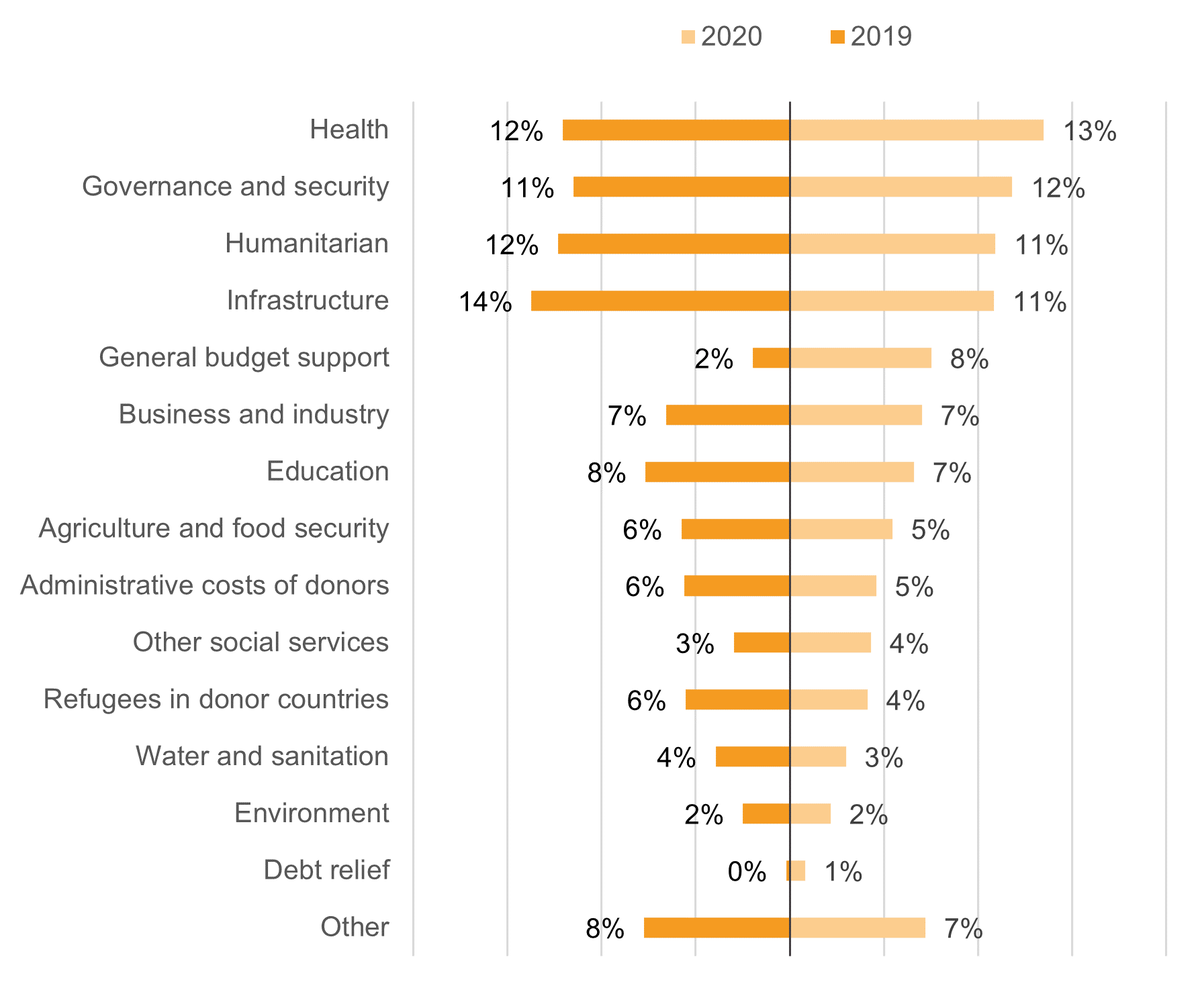
Bar chart showing that ODA to budget support, health and governance increased in 2020, while spending on infrastructure and water and sanitation saw the largest fall from 2019
Source: OECD DAC
Notes: Based on the sector allocations of DAC members and multilateral bodies combined.
Aid not transferred to developing countries
Every year, around one fifth of reported bilateral ODA results in no direct transfer of resources to developing countries. A number of activities are allowed to be reported as ODA, despite them not resulting in any resource transfer to other countries, we call this non-transfer aid. These activities include:
- Educating students from developing countries in donor-country universities
- Administrative costs of donors
- Debt relief
- Promotion of development awareness in donor countries
- Costs of housing refugees in donor countries
In most of these cases, any expenditure takes place within the donor country. In the case of debt relief, no money is spent, but liability is removed from the developing country – usually this includes accumulated interest, which was not included in the original debt.
During the last decade the proportion of non-transfer aid in total bilateral ODA peaked at 25% in 2016 due to a very large rise in in-donor refugee costs between 2014 and 2016.
This proportion then fell back to less than 20%, dipping further in 2020 as much of the ODA designed to support developing countries during the pandemic was of a type that did result in transfers of resources – for example, budget support from bilateral donors more than doubled between 2019 and 2020.
Figure 11: Half of ODA from DAC donors in 2020 went to specific projects, but 18% was not transferred to developing countries
The composition of ODA from DAC donors in 2020 (non-transfer elements in grey)
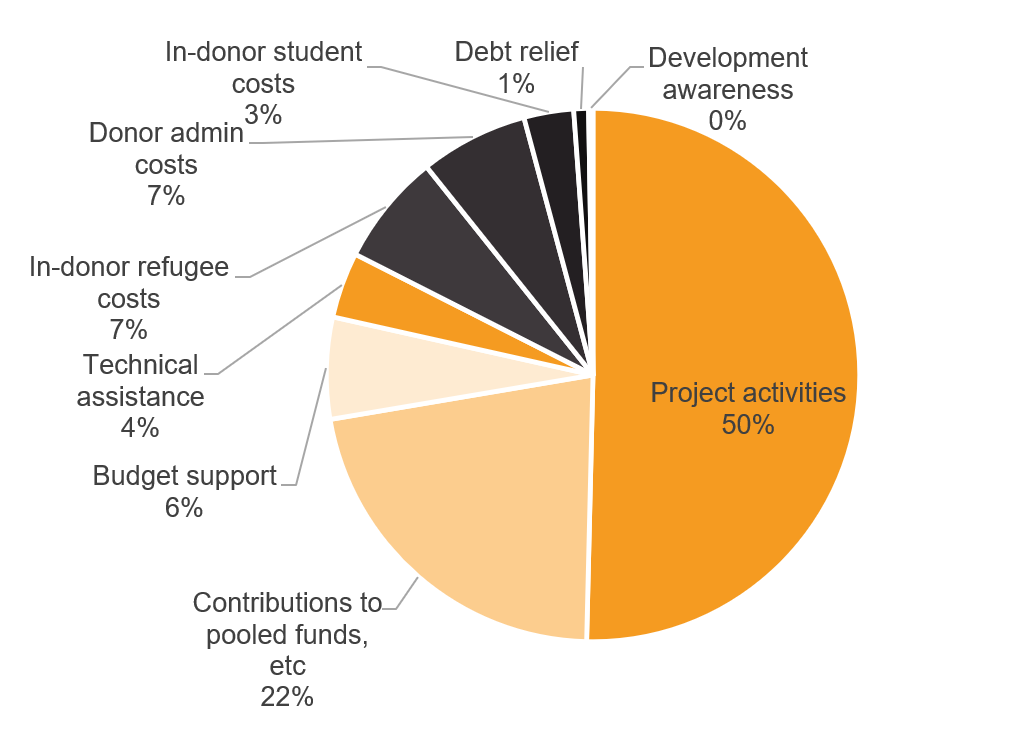
Pie chart showing that half of ODA from DAC donors in 2020 went to specific projects, but 18% was not transferred to developing countries
Source: OECD DAC.
Conclusion
At the time of writing, it is too soon to definitively assess the effect of the war in Ukraine on ODA, but the effects of the Covid-19 pandemic can be seen in the OECD data for 2020 and 2021, with some insights also discernible from data reported to IATI in 2021.
Although ODA reached new peak levels in both 2020 and 2021, donor disbursements in these years were obviously affected by the onset of Covid-19. In 2020, the increase in ODA was driven by a large rise in budget support lending, especially from the IMF. In 2021, the increase was almost entirely due to the inclusion of newly developed Covid vaccines in the ODA statistics. While this response from donors was undoubtedly valuable in the context of the developing pandemic, it presents issues for developing countries and donors in the future.
Loans to developing country governments in 2020 have added to the debt burden of developing countries. Billions of dollars of additional loans were advanced to the countries experiencing the most extreme poverty in 2020 – many of which were already at risk of debt distress. The issue is compounded by the fact that loans from the IMF are intended to be short-term – repayable within 10 years. This means that addressing the issue of developing country debt is likely to become a key priority in coming years.
Donated vaccines supported many developing countries in their Covid-19 response. However, there was a marked difference between the US, which mainly purchased additional vaccines specifically for developing countries, and other donors, which donated excess supply from their domestic vaccine stocks. This meant that many donors were able to report vaccine doses worth millions of dollars as ODA without spending additional money on developing countries. This could lead to a future fall in some donors’ reported ODA levels when the transfer of vaccines reduces.
The decision of the UK to abandon the 0.7% ODA/GNI target is regrettable. The UK’s ODA would have fallen anyway due to the economic effect of the pandemic on GNI levels, but the decision to abandon the ODA/GNI target led to by far the largest fall in ODA of any DAC member.
As poverty becomes increasingly concentrated in LDCs, ODA spending should also increasingly prioritise these countries. However, there is no evidence that donors are doing this – the uptick in ODA to LDCs in the first year of the pandemic only served to restore LDCs’ share of ODA to the level it was at the beginning of the last decade. Also, loans have comprised a growing proportion of ODA disbursed to LDCs, raising the possibility of increased debt-service issues in the world’s poorest countries.
As the world recovers from the pandemic and responds to the impact of the war in Ukraine, donors and developing countries will need to deal with new issues as well as problems that existed pre-Covid. ODA urgently needs to be reprioritised to the countries that need it most, at the same time as assisting those countries to face any issues arising from increased levels of debt. Assisting Ukrainian refugees and, ultimately, Ukrainian reconstruction should not come at the cost of reduced support to the world’s poorest nations. In these countries, assistance to offset the effect of higher food prices will be vital and activities that had to be paused due to the pandemic, for example, some infrastructure projects, will need to be restarted.
ODA will play a vital role in the coming years. Donors who cut their aid to developing countries during the pandemic should reverse these cuts at the earliest opportunity.
This page was updated on 01/08/2022.
Annex 1 – donor agencies included in IATI analysis
This paper analyses transactions published to the International Aid Transparency Initiative (IATI). A direct download was taken (on 1 April 2022) of all the data in the IATI registry. [6] The analysis focuses on a selected group of key bilateral donors, international financial institutions (IFIs) and multilateral institutions reporting to IATI. The quality of data provided by these donors for disbursements is assessed and adjudged to be usable or not. More up-to-date evaluations of usability are provided monthly in our interactive tracker. [7]
Some aspects of reporting which are considered to assess whether a reporting organisation has usable data are: (i) timeliness, (ii) completeness, (iii) magnitudes. Notable exclusions include:
- Germany's Federal Ministry for Economic Cooperation and Development (who report total disbursement data for each activity on the latest transaction date)
- France's Agence Française de Développement (who report data on activities cumulatively)
- The Federal Government of the United States (who had only reported up until October 2021)
Key bilateral donors, IFIs and multilateral institutions used in the analysis of IATI disbursements
Bilateral donors
- Belgium – DG Development Cooperation and Humanitarian Aid
- Canada – Foreign Affairs, Trade and Development Canada
- Denmark – Ministry of Foreign Affairs, Denmark
- EC – DG Neighbourhood and Enlargement Negotiations
- EC – ECHO
- EC – International Partnerships
- EC – Service for Foreign Policy Instruments
- Finland – Ministry for Foreign Affairs of Finland
- Germany – Federal Foreign Office
- Netherlands – Enterprise Agency
- Netherlands – Ministry of Foreign Affairs (DGIS)
- New Zealand – Ministry of Foreign Affairs and Trade
- Norway – Norad
- Spain – AECID
- Sweden
- Switzerland – Swiss Agency for Development and Cooperation (SDC)
- UK – British Council
- UK – Department for Business, Energy and Industrial Strategy
- UK – Department of Health and Social Care (DHSC)
- UK – Foreign, Commonwealth and Development Office (DFID)
- US – Millennium Challenge Corporation
- US – U.S. Agency for International Development
IFIs
- African Development Bank (AfDB)
- Asian Development Bank (ADB)
- European Bank for Reconstruction and Development
- Inter-American Development Bank
- Multilateral Investment Fund
- World Bank
Multilateral donors
- Gavi, The Vaccine Alliance
- Global Fund
- International Committee of the Red Cross
- International Development Law Organization (IDLO)
- International Fund for Agricultural Development (IFAD)
- UNAIDS
- UNDP
- UNICEF
- UNIDO
- Unitaid
- UNOCHA
- UNOCHA - Central Emergency Response Fund (CERF)
- World Food Programme
Annex 2 – DAC donors’ ODA contributions in 2020 and 2021
Table 1: Most DAC donors increased ODA between 2020 and 2021
| Donor | 2020 (US$ million) | 2021 (US$ million) | Change (US$ million) | % change |
|---|---|---|---|---|
| Australia | 3,297 | 3,444 | 147 | 4.5% |
| Austria | 1,342 | 1,460 | 117 | 8.7% |
| Belgium | 2,513 | 2,571 | 58 | 2.3% |
| Canada | 5,806 | 6,271 | 465 | 8.0% |
| Czech Republic | 336 | 362 | 26 | 7.8% |
| Denmark | 2,798 | 2,874 | 77 | 2.8% |
| Finland | 1,362 | 1,436 | 74 | 5.4% |
| France | 14,768 | 15,448 | 679 | 4.6% |
| Germany | 30,697 | 32,232 | 1,535 | 5.0% |
| Greece | 347 | 264 | -83 | -23.9% |
| Hungary | 455 | 455 | 0 | -0.1% |
| Iceland | 64 | 72 | 8 | 11.7% |
| Ireland | 1,019 | 1,169 | 150 | 14.8% |
| Italy | 4,473 | 6,017 | 1,543 | 34.5% |
| Japan | 15,719 | 17,619 | 1,900 | 12.1% |
| Luxembourg | 491 | 539 | 48 | 9.7% |
| Netherlands | 5,695 | 5,288 | -408 | -7.2% |
| New Zealand | 598 | 681 | 83 | 13.8% |
| Norway | 5,288 | 4,673 | -615 | -11.6% |
| Poland | 870 | 952 | 82 | 9.4% |
| Portugal | 432 | 450 | 17 | 4.0% |
| Slovak Republic | 150 | 151 | 1 | 0.6% |
| Slovenia | 96 | 115 | 18 | 19.0% |
| South Korea | 2,366 | 2,855 | 490 | 20.7% |
| Spain | 3,148 | 3,542 | 394 | 12.5% |
| Sweden | 7,026 | 5,927 | -1,100 | -15.7% |
| Switzerland | 3,705 | 3,927 | 222 | 6.0% |
| UK | 20,074 | 15,814 | -4,261 | -21.2% |
| US | 36,996 | 42,311 | 5,315 | 14.4% |
| Total | 171,903 | 178,916 | 7,013 | 4.1% |
Source: OECD DAC.
Annex 3 – the top 20 recipients of ODA in 2020
Table 2: Top 20 recipients of ODA in 2020
| Rank in 2020 | Country |
ODA in 2019
(US$ million) |
ODA in 2020
(US$ million) |
Rank in 2019 |
|---|---|---|---|---|
| 1 | Bangladesh | 4,465 | 5,357 | 2 |
| 2 | Ethiopia | 4,738 | 5,275 | 1 |
| 3 | Afghanistan | 4,186 | 4,135 | 3 |
| 4 | Kenya | 3,243 | 3,976 | 5 |
| 5 | DR Congo | 2,886 | 3,376 | 7 |
| 6 | Nigeria | 3,359 | 3,363 | 4 |
| 7 | Uganda | 2,063 | 3,071 | 14 |
| 8 | Somalia | 1,639 | 2,924 | 19 |
| 9 |
Syrian Arab
Republic |
2,919 | 2,869 | 6 |
| 10 | Myanmar | 2,069 | 2,866 | 13 |
| 11 | Jordan | 2,499 | 2,856 | 9 |
| 12 | Mozambique | 1,863 | 2,545 | 16 |
| 13 | Pakistan | 1,979 | 2,538 | 15 |
| 14 | Ukraine | 1,134 | 2,308 | 30 |
| 15 | Iraq | 2,078 | 2,301 | 12 |
| 16 | Tanzania | 2,167 | 2,260 | 11 |
| 17 | Ghana | 930 | 2,192 | 39 |
| 18 | Yemen | 2,401 | 2,008 | 10 |
| 19 | Niger | 1,464 | 1,914 | 22 |
| 20 | Morocco | 817 | 1,859 | 43 |
Source: OECD DAC.
Notes: Gross ODA disbursements to recipient countries from DAC members and multilateral organisations.
This page was updated on 20 November 2023
Notes
-
1
IMF World Economic Outlook April 2022. Available at: www.imf.org/en/Publications/WEO/Issues/2022/04/19/world-economic-outlook-april-2022Return to source text
-
2
Non-country specific ODA includes ODA that does not have a specified single-country recipient. This can include ‘developing countries unspecified’, which refers to ODA that benefits several regions or non-country programmable aid such as administrative costs, refugee-hosting costs and in-donor research costs. This category further includes ODA to ‘regional’ recipients (e.g. South of Sahara, Regional) which refers to ODA that benefits several recipient countries within the specified region. Where 'country-specific ODA' is used, it refers to ODA reported that is intended for a specific country recipient.Return to source text
-
3
Reporters that report usable data to IATI are detailed in Annex 1.Return to source text
-
4
See statement from the OECD DAC Head of Financing for Sustainable Development Division. Available at: https://oecd-development-matters.org/2022/04/06/covid-19-vaccines-and-official-development-assistance/Return to source text
-
5
Development Initiatives, 2021. Reversing the trends that leave LDCs behind: How ODA can be targeted to the needs of people living in greatest poverty post-pandemic. Available at: /resources/reversing-trends-leave-ldcs-behind/Return to source text
Related content
Donors at the triple nexus
DI Senior Policy & Engagement Advisor Sarah Dalrymple presents some of our recent analysis into how donors like Sweden and the UK are approaching the triple nexus between humanitarian, development and peace approaches in crisis contexts.
Implications of coronavirus on financing for sustainable development
DI Executive Director Harpinder Collacott summarises the possible impacts of the coronavirus pandemic on global development - including projections for extreme poverty, the future of different forms of financing, and the countries likely to be most impacted.
What do emerging trends in development finance mean for crisis actors?
DI's webinar ‘What do emerging trends in development finance mean for crisis actors?’ gives crisis actors key information on development finance to better understand what it means for them.

